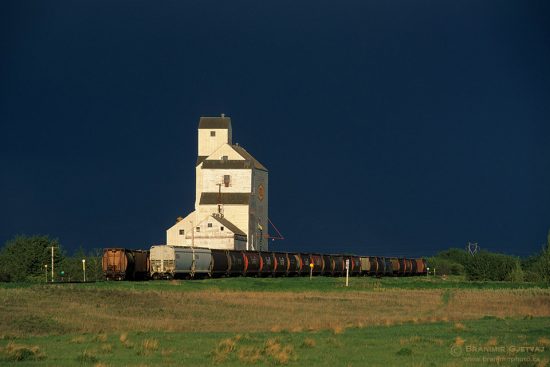The National Trust for Canada (NTC) has released today its latest Top 10 Endangered Places at Risk. NTC is a national charity that leads action to save historic places of cultural and natural significance. The organization’s goal is to inspire Canadians to identify and celebrate their heritage landmarks, cultural landscapes and communities, and conserve them for present and future generations.
Two prairie landmarks made the top 10 list: Saskatchewan’s grasslands and wooden grain elevators. These places that define identity, community spirit and a sense of belonging are slowly eroding due to neglect, shift in economics priorities, inappropriate development and weak legislation. First published in 2005, the NTC Top 10 Endangered Places List has raised awareness and supported efforts by local groups working to save them. Incidentally, I have extensively photographed these disappearing natural and cultural icons over 18 years of my travels throughout Western Canada. I shared images and stories with wide audiences about the importance of maintaining these historic places and what they mean to our cultural identity and quality of life.
Temperate grasslands are one of the major biomes on the planet. Because grasslands provide a very important source of food for human populations, they are one of the most altered ecosystems we inhabit. The majority of native grasslands in North America have been converted to grow crops for food and fuel and have lost their ability to stabilize the planetary systems. In the 1930s, a combination of unsustainable farming practices and extremely dry climate conditions caused extensive degradation of topsoil. You are probably familiar with the negative consequences of Dust Bowl and the impact on thousands of prairie farmers who abandoned their homesteads during the height of Great Depression.
In 1935, Canadian Parliament established the Prairie Farm Rehabilitation Administration with a goal to reclaim badly eroded agricultural lands and manage fragile grasslands through the Community Pasture Program. With a careful, conservation-based management, the CPP was successful in stabilizing and restoring grasslands throughout the Prairie Provinces. Today, 1.8 million acres of grasslands in the Community Pasture Program network represent the last remaining large tracts of prairie habitat, home to many species at risk as well as aboriginal and homestead heritage sites. In 2012, the federal government discontinued the CPP and initiated the transfer of federally managed community pastures to the provinces. Provincial interest in managing the land varies; the government in Manitoba expressed interest in supporting the unified management of pastures with conservation as a strong priority. In contrast, the Saskatchewan government is not interested in supporting conservation-based management and decided to relinquish control to small user groups and market forces.
The second heritage icons that are vanishing from prairie landscapes are, once ubiquitous wooden grain elevators. These prairie sentinels are deeply embedded in Canada’s farming psyche. Nearly 6,000 grain elevators used to dot rural landscapes of Western Canada. They formed a sense of identity and belonging to a place. They were symbols of farming life and the strength of rural communities. Changing technology and industrialized scale of contemporary farming made many of the wooden structures obsolete. They have been torn down at an alarming rate. Today, less than 14 percent of the traditional wooden structures still stand. Only 23 elevators have received heritage designation, a minimal form of protection if there aren’t sufficient funds raised by local communities for their upkeep.




